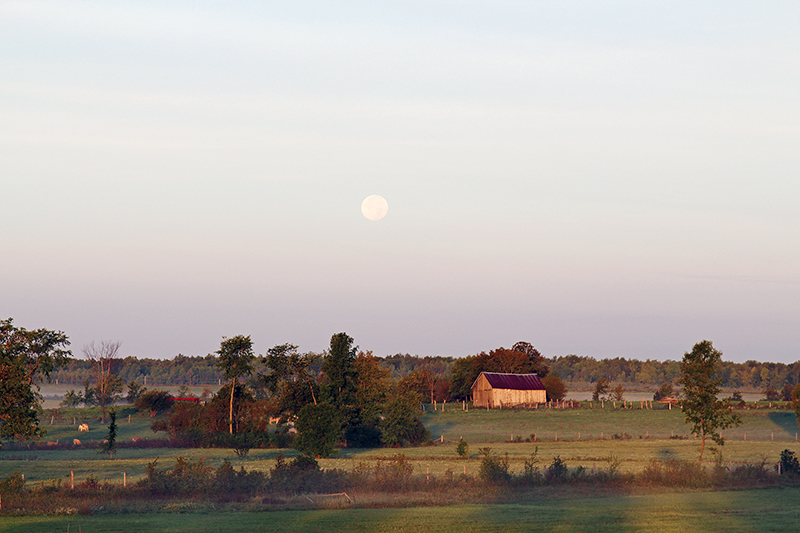Springfield Farms is an Apple Hill farm that shines with beauty and tranquility. Courtesy Photo
By M. Eleanor McGrath
AgriNews Contributor
A year into this pandemic thing and we all know what we’re missing: from human connections, to dining out and travel to sunny beaches.
Much has been written about the ongoing financial devastation to small business, hospitality and tourism sectors, often hitting close to home. But in South Eastern Ontario there is possibly a new and dynamic rescue plan that can be written from the Farm Table to Main Street’s Sidewalks using the infrastructure that is embedded in the heartland of rural Ontario – the same spirit that built the barns that mark our landscape, one of cooperation and concern for our neighbours.
In the final act of the 1930s movie, “Dorothy and the Wizard of Oz” Glinda the Good Witch shares with Dorothy, the girl from a farm in Kansas, that she always had the key to getting home, back to the farm: “Click your heels together three times and say ‘There’s no place like home’ and you’ll be there.” This is not a high-brow economic theory that farms will help save main street, but just a homespun thought weaving together wise words from women leading the charge across Ontario to assist in the renewal of our tourism and culinary industries. It is time to examine what we have here at home in South Eastern Ontario in abundance and what we can offer to those who want to return home.
According to Lori McIsaac, Director of Experiential Tourism Development – South Eastern Ontario, “With an abundance of farms throughout the South Eastern Ontario (SEO) region, AgriTourism is becoming a key driver in attracting visitors and is a prime focus for the region. The desire to move outside, get back to nature and dig (pun intended) a little deeper to learn about the local food that is available in SEO provides the perfect opportunity for visitors to enjoy amazing outdoor educational experiences, whether it be a farm tour, field to fork dinners, forest foraging or glamping.” The increasing interest in agriculture is being driven by many factors and many of them self-centred as “where is my food coming from” or “how do I get to enjoy nature in a safe environment” and this is where farms can be the starting point for a lasting economic renewal in our Region 9 Regional Tourism (RTO9) region.
Whether you own 10 acres or 1000 acres, as a farmer you now are at the top of mind of most Canadians and have something that they want, and in marketing this is a powerful place to be. The time is now to recognize how valuable your farming knowledge is, including the history surrounding your fields and community. This means that you even have the ability to attract the next generation of farmers which might be a professional young couple seeking the challenge and beauty not found in the cement bordered neighbourhoods of Toronto or Ottawa. However, it is equally important to note that many farms in our region are restricted by insurance, biosecurity or crop safety prohibiting their participation in the on-site tours, glamping, etc. However, this is only one component of AgriTourism and the ability to strengthen our regional economy based on what we do best is the fundamental strength of this proposition — as farms feed the nation. The Culinary Tourism Alliance, president & CEO, Rebecca Mackenzie states, “Tourists are looking to connect with people, places and immerse themselves in the host destination. Increasingly people travel for food related experiences or recognize that their travels are enhanced by these. Food plays an important role in creating multisensory experiences that can help visitors connect in authentic ways to the local landscapes, heritage and culture.” Growing food, imparting knowledge about farming to tourists and guests, alike, will equally enhance the experience of the traveller as they motor across our landscape spending time and money to learn the way of the farmer.
But back to our barn building heritage, when groups of men gathered to plane the beams, climb the trusses and then sit down for a meal cooked by the community women and reflect on a job well done – we need to harness that very spirit now for our main streets to survive. The crops that are soon to be sown could become the ingredients of a meal on the local restaurant table enjoyed by a visitor. This is where marketing our farming crops to local businesses is sadly lacking. What if a concerted effort was made by an organization that most of us belong to, the Ontario Federation of Agriculture (OFA) to partner with the Culinary Tourism Alliance and RTO9 and bridge the field to the fork? Valerie Keast, Program Manager of Feast On® for the CTA explains the ethos of their program: “Supporting our local economy and Ontario’s farmers is important, especially for our foodservice industry. Feast On® is a certification program that recognizes businesses committed to sourcing and celebrating Ontario grown food & drink. It is one of the many ways that Culinary Tourism Alliance is contributing to building Ontario’s food identity. We work to connect chefs directly to producers in order to increase awareness for local products, sourcing systems, and sustainable practices, while building our local food culture and its role within tourism.”
Here in South Eastern Ontario we have a powerful tale to tell, collectively and uniquely separate from the rest of the province. Mackenzie explains, “With an increased interest in where our food comes from and how it is grown and raised, agritourism enables farmers to diversify on-farm revenue while also providing consumers with a connection to the land and learning. Host communities need to consider what policies and land use regulations may need to be revisited and evolve in order to enable this type of development to take on prime agricultural land.” And equally, Lori McIssac is promoting AgriTourism through grants and outreach programs to assist the farmer, small business and tourism operator to build this diversity into their business plan: “The interest has never been more in demand than now and RTO 9 is working with farms throughout the region to help bring new and exciting experiences to visitors looking for an outdoor experience that offers an opportunity to experience nature at its productive best!”
We need to focus our energies now more than ever to promote AgriTourism and all of its benefits to a rural community, not just to the tourist but to the politicians at all levels of government. Just as our ancestors raised the barns, we can raise awareness that we need AgriTourism to function and be incorporated into the allowed uses of Agriculture and Rural land. We need the CRA to accept that revenue streams generated by AgriTourism are included as Farm Income and the Ontario Province’s $7000 gross farm income threshold – as you cannot have an AgriTourism operation in a Toronto backyard! And when we all, both conventional and organic, both small and large farms rally together we will build a community that will welcome everyone as their home away from home. The alternative is that we will miss the exciting opportunity in 2021 to share the beauty of South Eastern Ontario with our fellow Ontarians and in the future, the international tourist will just drive past us on the Highway 401. And so just as we hope for the best weather this spring for planting, let’s hope that we galvanize around AgriTourism to share our agricultural region with anyone seeking to fall in love with food, farming and our main streets across RTO9.













